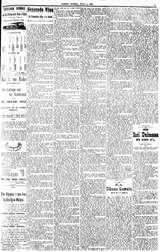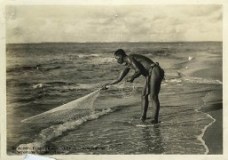Digital Collections
Celebrating the breadth and depth of Hawaiian knowledge. Amplifying Pacific voices of resiliency and hope. Recording the wisdom of past and present to help shape our future.
D. Kahaulelio
July 1902
KA LAWAIA MOI ME KA UPENA.—Ua kamailio aku au ia oukou, ma ka lawaia moi ana me ka paea. Ma na kai konohiki a pau o ko makou wahi, he kapu loa ka moi, a ma Makila nei, ua noa na iʻa e ae, me ka moi, i na hoaaina e noho ana maluna o ka aina, aka, o na kanaka no nae o na ahupuaa e ae, kii no lakou i ka moi i kahi wa, a mamuli o ka lilo ana aku nei o kakou i teritori no Amerika, ua ao aku paha kahi poe, ua noa na kai i keia wa, nolaila, ua alahula na kai konohiki apau i ke kii ana i ua moi nei. O na upena malua paloa, oia ka upena hoohana nui ia ma keia ano lawaia, i ka malama o Dekemaba i hala, o ka M. H. 1901, ua hoike ae na Rev. E. S. Timoteo me Rev. S. Kapu i ko laua akamai lawaia moi, ma ke kai o Launiupoko, he kai kapu keia, a ua hoolimalima ia e koʻu kaikuaana, a ua ike no paha laua, aia no o papa ma ka hoe, nolaila, hele no laua la e lawaia, elua no kuu ana a ua mau lawaia nei o ka ia loa, hooohikihiki maluna o ke kaapio ka moi, a lawe mai ana ka Rev. S. Kapu he mau kauna moi nui he elima a eono paha me koʻu ike ole aku, o ka leo wale no kaʻu i lohe aku, i puka aku koʻu hana a ninau i koʻu mama, ihea ae nei ka anela i walaau ae nei? I lawe mai nei i ka moi na kakou, hoike ka hoi na keiki o Hawaii i ke akamai lawaia, i hele aku ka hana i ka halawai, e ku mai ana kaulai o ka moi iloko o ka pa o Wainee, a ina i noho loihi hou iho, ina paha o ka laua no ka hele i ka lawaia ina aole pilikia o ka Ahahui Nui o ka Paeaina. Ke noho mai i Lahaina nei, pau papalua no ia e Kamalama iki pokii, o ka lawaia kanaka no, o ka lawaia kanaka no, o ka lawaia [sic] no. Mahalo piha, ai wahi moi a o ka poe palaualelo, i na keiki o hana io ka ua ia Kohala, me ke keiki o ka ua kaulana Kanilehua o Hilo, ina paha i hawanawana iki mai i ke keiki o ua kaulana Paupili, ina hoi ua ikea na ai a Wahinemanua.
Nui lealea i na keiki eueu o Keawe, a e hoomau aku olua i ka olua hana maikai, a mai hoopoina nae i ka ninau pono ana i ke ano o ke kuu upena ana ia Rev. O. Nawahine, ka hiapaiole o ka moana kai huhu o ka lae ino o Mokuhia me ka lae o Hawini e oni ae la i ke kai, nolaila o ka hana pono wale no a na anela makaukau a ike lawaia, e like me Rev. S. L. Desha, e holo mua i Kona lawaia ahi, a ku kaulai, hoouna mua mai naʻu e malama, a pela no hoi o Rev. C. M. Kamakawiwoole o ke all ulili, e lawaia moi iho no hoi a ku kaulai hoouna mua mai no, a pela no hoi o Rev. O. Nawahine he mau la hai aku keia o ke aku o ua kai oehuehu la o na Waieha, e alu ka pule ia Hakalau, aole hoi ka manao mai, o makou wale no me kaʻu mau anela lawaia, aia no ka pono, o ka lawa o na tausani e hiki mai ana. E na kaeaea o na Kona Hema i ka lawaia, nokea [sic] mai ka hauliuli ka iʻa kaulana o ka aina, ia B. Lazaro, Hon. S. W. Kaai, aole o ke kaukai wale mai no a na ka lawaia hookahi, oiai ke lohelohe wale ia mai nei no he 300 haneri ka nui o na haumana Kula Sabati o na Kona, nui kela, nani no hoi, mahalo piha.
KA LAWAIA KA LAAU.—Oia kekahi lawaia hana mau ia e ko Molokai poe, ma ka huli i kapaia o Kona, oiai he kai kohola ia aoao, oia ka aoao e huli mai ana i Lahaina, a pela no hoi me ka Lanai poe, a me ko Lahaina nei, me na upena paloa makalua a makolu, e kuu ia ana e na lawaia elua ma kahi kuku ame kahi, alaila, o na kane ame na wahine a kamalii, e paa ana me na laau, lolo niu, a e au ana me ka hahau i ke kai mawaena o ka upena, pela e hana ai hiki i ka hui ana o na kuku me na kanaka, alaila, e nai maikai no hoi a hiki i ka hui ana o ka upena, he nui na ano iʻa e loaa, anae, awa kalamoho, kala, oio, a pela aku: nolaila, ma ia ano i kapaia ai he lawaia ka laau.
Net Fishing for Moi and Kalaau Fishing
Translated by Mrs. Mary Kawena Pukui
The Smithsonian Institution National Anthropological Archives: Mary Kawena Pukui collection #37 Fish and Fishing.
NET FISHING FOR MOI.—I have told you about pole fishing (paeaea) for moi but not how to catch them with a net. At all the beaches of our place under the charge of a konohiki, the moi was a very kapu fish here in Makila. Other fishes as well as moi were free to be caught by the tenants of the land but the people from other ahupuaas caught the moi only at times. Because we have become a territory of America, some people must have taught others that the fisheries are free now and so the moi in the sea fisheries under all the konohikis are freely caught. Paloa nets having meshes of two fingers width were used in this kind of fishing. In the month of December last, in the year 1901, Rev. E. S. Timoteo and Rev. S. Kapu told me of their skill in catching moi in the sea of Launiu-poko. This was a kapu sea and leased by my older brother. Perhaps they knew that Papa was occupied with his oars, so they went fishing. With two hauls of the net these fishermen of a long day, they carried away their moi fish on a hack. Rev. S. Kapu brought several large moi fish, about five or six without my seeing him. I heard his voice and I came out to ask my Mama, "Where is that angel that spoke to you?" "He brought us some moi." The son of Hawaii showed his skill in fishing and when I went to [sic] meeting I saw the moi drying on the fence of Wainee. If he were not so busy preparing for the great inter-island meeting to be held here in Lahaina, Kamalama, the little brother would be doing the double duty of fishing for men and for moi. Thank you very much, for we lazy fellows eat, oi [sic] from the boy who works hard as the rain falls in Kohala and from the boy of the famous Kanilehua rain of Hilo. If they had whispered a little to the boy of the famous Paupili rain, perhaps the food of Wahinemanua would have been revealed (which of us is the better fisherman).
The lively boys of Keawe have had much fun and so keep up the good works. Do not forget to ask how Rev. O. Nawahine uses his net, the fearless one of the angry seas of the rough cape of Mokuhia and the cape of Hawini that stretches itself out into the sea. The best thing for the angels who are able fishermen like Rev. S. L. Desha to go fishing for ahi at Kona first, dry them and send them up for me to take care of; Rev. C. M. Kamakawiwoole too, of the narrow cliff side trails to catch some moi, dry them and send them here to me, Rev. O. Nawahine also, for these are the days to pursue after the aku of the angry sea of Waiehu. Let your prayers unite to reach Hakalau, and not leave it all to me and my fishing angels. It is well to have enough to supply the thousands that are coming. O fishing experts of South Kona S. Lazaro and Hon. S. W. Kaai catch an abundance of hauliuli, the famous fish of your land and do not depend entirely on the lone fisherman for it is rumored that there are about three hundred Sunday School pupils in the Konas. That is a goodly number, beautiful; much praise to you.
KALAAU FISHING.—This is one kind of fishing much practiced by the people of Moloka‘i on the side called Kona, for that is the side that had the shallow sea. It is also the side facing Lahaina. Those of Lana‘i and of Lahaina too, practice it with palea nets of two or three fingers width. It is lowered by two men in charge of the ends. Men, women and children, holding sticks or fibers or coconut stumps, swim about beating the water toward the center of the net. They continue this until the men at the ends of the net come together. Many kinds of fish are caught such as mullet, awa, rather large, or they are put within. Then calm settles down.

photo credit: www.nupepa.org

photo credit: Kamehameha Schools Photo Archives